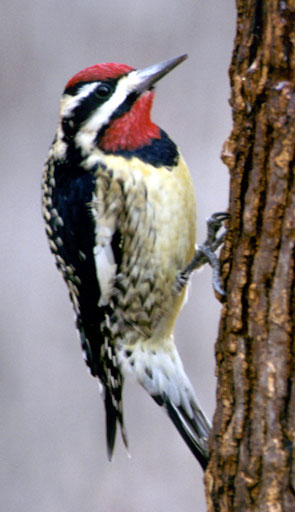Yellow-bellied Sapsucker
From Wikipedia, the free encyclopedia
[Photo] Yellow-bellied Sapsucker, Sphyrapicus varius, male. Location: Durham, North Carolina, United States. Attracted to artificial sap wells (filled with corn syrup) for photography. Date 1996-02-25. Author Patrick Coin http://commons.wikimedia.org/wiki/User:Cotinis
The Yellow-bellied Sapsucker, Sphyrapicus varius, is a medium-sized woodpecker.
Adults are black on the back and wings with white bars; they have a black head with white lines down the side and a red forehead and crown, a yellow breast and upper belly, a white lower belly and rump and a black tail with a white central bar. Adult males have a red throat; females have a white throat.
Their breeding habitat is forested areas across Canada, eastern Alaska and the northeastern United States. They prefer young, mainly deciduous forests. There is also a disjunct population found in high elevations of the Appalachian Mountains in Virginia, Tennessee, and North Carolina. They nest in a large cavity excavated in a deciduous tree, often choosing one weakened by disease; the same site may be used for several years. Usually, these birds will mate with the same partner from year to year, as long as both birds survive. They sometimes hybridize with Red-naped Sapsuckers or Red-breasted Sapsuckers where their breeding ranges overlap.
These birds migrate to the southeastern United States, West Indies and Central America, leaving their summer range. This species has occurred as a very rare vagrant to Ireland and Great Britain.
Like other sapsuckers, these birds drill holes in trees and eat the sap and insects drawn to it. They may also pick insects from tree trunks or catch them in flight. They also eat fruit and berries.
They drum and give a cat-like call in spring to declare ownership on territory.
Apparently because the name sounds amusing, yellow-bellied sapsucker is sometimes used as a comic, generic term for an unusual animal.
http://en.wikipedia.org/wiki/Yellow-bellied_Sapsucker
| The text in this page is based on the copyrighted Wikipedia article shown in above URL. It is used under the GNU Free Documentation License. You may redistribute it, verbatim or modified, providing that you comply with the terms of the GFDL. |
|

